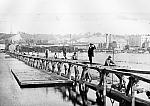
Grand Rapids Water Story, 19th Century, Part VIII
Away back in 1889, when the Hydraulic Water company and the Eastern syndicate composed of Coffin & Stanton, S. D. Loring, Woodbury & Moulton, Elliott, Johnson & Co. and M. R. Crow, were negotiating a deal whereby the company would receive $100,000 for immediate uses and the promise of financial backing in its effort to secure control of the city water works, J. M. Howell, an expert engineer in the employ of the syndicate, was sent on here to investigate the situation. His findings even though fifteen years old, are still of interest as the principal points made then are applicable today. The Hydraulic company plant has been little changed in the fifteen years, except that it has suffered natural deterioration, as has been pointed out before. The city system has been extended, but it still depends upon river water. The essential portions of the report, dated April 2, 1889, follow:
“The present supply of water available from the Hydraulic company springs is about 1,500,000 gallons in twenty-four hours; new galleries now being run to the wall, intercept other small springs in the vicinity and I estimate that at least 2,500,000 gallons of spring water can be obtained from the vicinity of the pump house.”
Can Increase Supply by Filtering
“The increase of water supply after the springs in the vicinity are drained can, I believe, be most economically obtained by filtering the water of Grand River, from which source there is water in abundance for a city many times the size of Grand Rapids.
The distribution system of the Hydraulic company is large enough to connect with the stand tower of high level service; and a reservoir should be provided for the low level service; if this provision is made by building, large mains can then be connected to the reservoir, and if the provision is made by buying the city’s reservoir and water works plant, then the proper sized connections are already there.
But the 12-inch force main from the pump house to town is not suitable for a greater length of distribution pipes than the Hydraulic company already has, and if it buys out the city works the capacity of the force main will not be adequate.
As the ultimate solution of the water works problem for Grand Rapids naturally points to the uniting of the two sets of works under one management, either for the city or a private corporation, we look for some economical use to which two independent systems of distribution pipe can be supplied.”
Two Prices for Water Advised
“By establishing two price rates for water, the river water could be used for fire and manufacturing purposes, thus leaving the spring water for domestic use. By thus limiting the use of spring water an ample supply would be available for domestic purposes without an expensive and – as most large cities find it – an expedient attempt to filter the entire supply. This plan might be found practical if the coalition took place in time to stop the laying of expensive large sizes of pipe and the adoption of quite small mains in general by the Hydraulic Company, except a system of feeders such as the present sizes.
This is would seem the best policy to do in any event, as the city’s pipe system, running as it does far in advance of the Hydraulic Company’s and being of a proper size for fire service, will inevitably do that service, and no hope can be entertained that the company’s pipe system will get more to do than supply the domestic demand in the residence portion, and possibly certain manufactories requiring pure water in the manufacturing districts. The private company has the hotels now.
The cost of extensions can be reduced one-half if the Hydraulic Company gives up the idea of affording fire protection with its system of pipes.”
The Situation Summed Up
In his summary of the situation the engineer says in substance:
“The Hydraulic company has two valuable possessions: the one is its perpetual charter; the other its spring water.
The water rates have recently been reduced by the city water commission, the private company reducing its rates the same. They are still at a fair price, running about the same as the average elsewhere.
The company’s supply is limited and not to be depended upon for more than 2,000,000 gallons in dry times.
The question is how can this 2,000,000 gallons bring the best revenue? If no filtered river water is used by the Hydraulic Company, it will always be spring water vs. river water, quite possible, but hardly probably.
The political tendencies of the situation are, of course, problematical. The worst that could happen would be that a city administration might come in and reduce the water rates to such a point as to leave no profit over the cost of plumbing, and throw the cost of the public water supply on the people in the form of a direct tax.
In one other way can the Hydraulic Company’s profits be cut down, viz., by taxation. But the extreme limit any court will allow in my opinion is about $4 per $1,000 on $140,000, or $5.600 per annum after the extensions are made.”
Prophecy for the Future
The engineer estimates operating expenses at about $19,400 a year, and 6 per cent interest on $350,000 worth of bonds at $21,000, calling for an annual expenditure of $40,000. He places the value of the plant at $150,000, and estimates the cost of forty-six miles of additional small pipe at $120,000. He estimates the cost of a 4,000,000 gallon reservoir at $20,000.
In concluding, the report says: “The larger the city grows the more difficult will it be to filter the entire supply, and the Hydraulic Company, having enough water for domestic consumption of a city of 200,000 inhabitants and more, can I believe, with judicious management, sustain itself unless by some unaccountable political maneuver money is raised to filter the public water supply.”
Grand Rapids Press, October 21, 1904
Transcribed by Rebecca Smith-Hoffman
Article Posted June 14, 2014

 facebook
facebook











